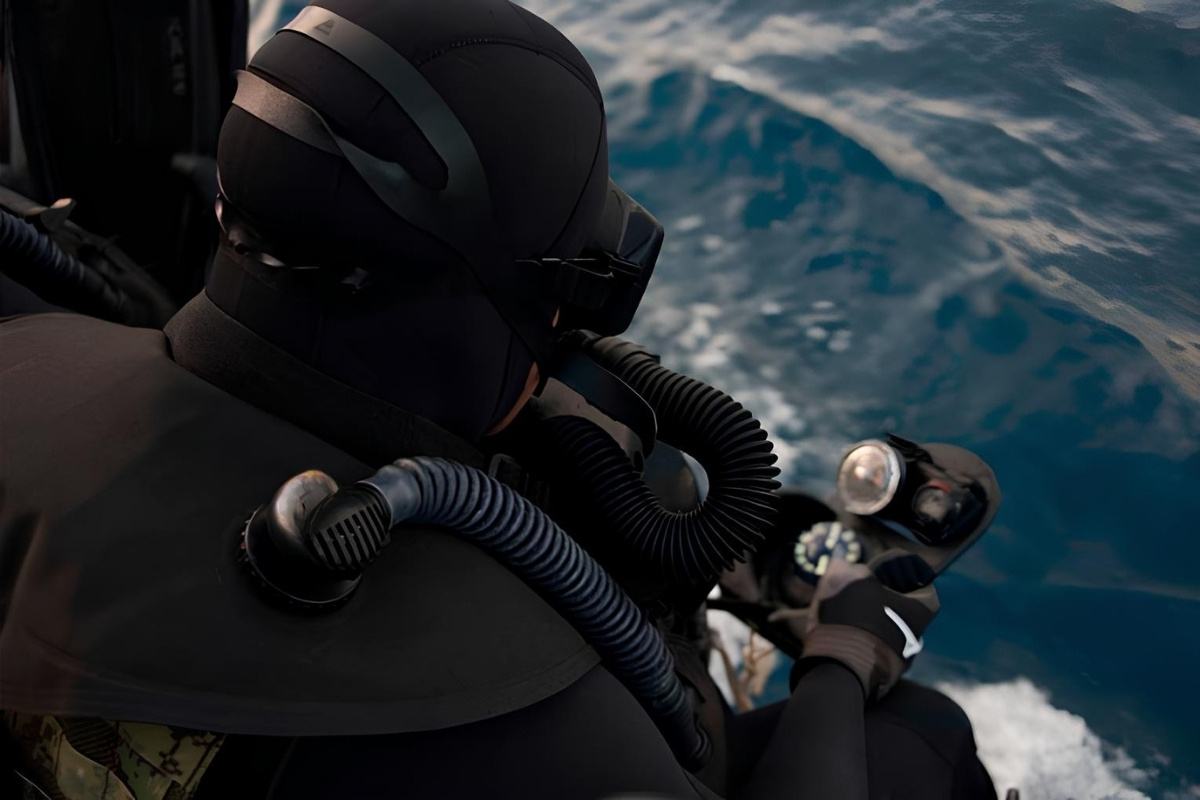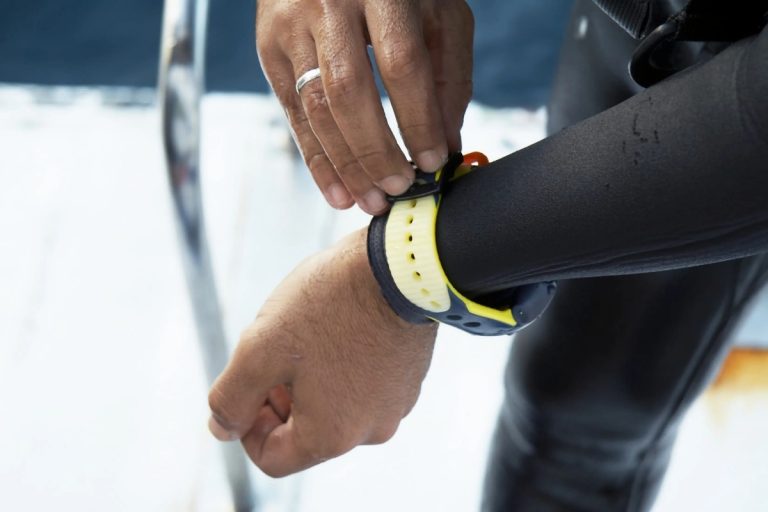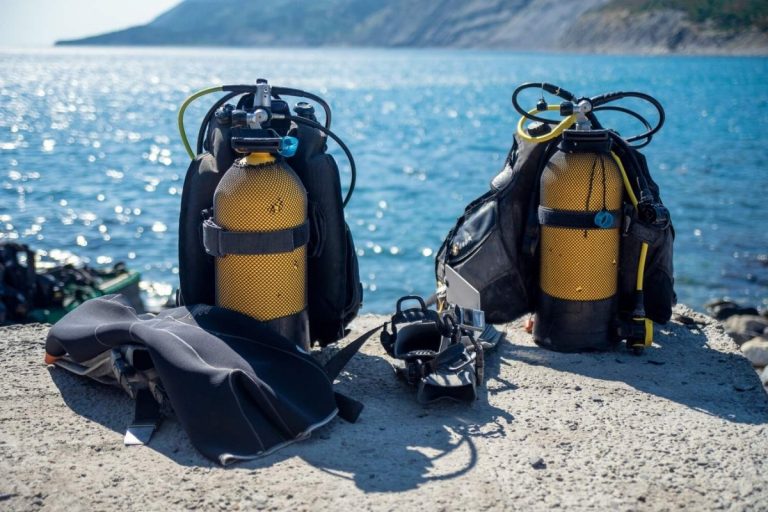- Understanding Dive Computers
- Basic Metrics of Dive Computers
- Advanced Metrics Explained
- How to Read Your Dive Computer
- Different Algorithms in Dive Computers
- Choosing the Right Dive Computer
- Maintenance and Care of Dive Computers
- The Future of Dive Computers
- Frequently Asked Questions
- Navigating the Depths with Confidence
Understanding Dive Computers
Modern diving has been transformed by technology that puts critical safety information right at your fingertips. The importance of dive computers cannot be overstated in today’s underwater adventures, as these sophisticated devices have become essential companions for divers at every skill level.
A dive computer serves as your personal underwater safety monitor, constantly calculating and displaying vital information that keeps you within safe diving limits. Unlike the static dive tables of the past, these intelligent devices adapt to your specific dive profile in real-time, providing personalized data that reflects your actual underwater experience.
The shift from traditional dive planning methods to computer-assisted diving represents one of the most significant safety advances in recreational diving. These devices eliminate much of the guesswork and human error that could occur with manual calculations, while offering a level of precision that was previously impossible to achieve.
What is a Dive Computer?
A dive computer is essentially a specialized underwater calculator that continuously monitors your dive parameters and performs complex mathematical calculations to determine safe diving limits. These compact devices combine multiple sensors with sophisticated algorithms to track depth, time, temperature, and in some cases, your breathing gas consumption.
The computer processes this information through decompression algorithms that model how nitrogen absorbs into and releases from your body tissues during a dive. This real-time analysis allows the device to provide accurate no-decompression limits and, when necessary, calculate required decompression stops.
Most modern dive computers feature waterproof displays that remain clearly visible underwater, along with audible and visual alerts to warn you of potentially dangerous situations. The integration of multiple functions into a single, reliable device has made dive computers indispensable tools for safe diving practices.
How Dive Computers Enhance Safety
Safety enhancement comes through continuous monitoring and instant feedback about your dive status. The computer tracks your ascent rate, alerting you immediately if you’re rising too quickly, which helps prevent decompression sickness and lung overexpansion injuries.
Real-time nitrogen loading calculations provide accurate information about your current saturation levels, allowing you to make informed decisions about dive duration and surface intervals. This personalized approach accounts for your specific dive profile rather than relying on generic table values.
The automatic logging feature creates detailed records of every dive, including maximum depth, bottom time, and surface intervals. This historical data helps you track your diving patterns and provides valuable information for future dive planning.
The Role of Dive Computers in Recreational Diving
Recreational diving has been revolutionized by the accessibility and reliability of modern dive computers. These devices have made diving more enjoyable by reducing the complexity of dive planning while simultaneously increasing safety margins through precise monitoring.
For recreational divers, computers eliminate the need to carry separate depth gauges, timers, and dive tables. This simplification allows divers to focus more on the underwater experience rather than constantly checking multiple instruments and performing mental calculations.
The adaptive nature of dive computers means they adjust to your actual dive profile, often providing longer bottom times than conservative dive table calculations would allow. This efficiency maximizes your underwater time while maintaining appropriate safety margins.
Basic Metrics of Dive Computers
Understanding the fundamental measurements your dive computer displays forms the foundation for safe diving practices. These basic metrics provide the essential information needed to monitor your dive status and make critical safety decisions underwater. Advanced features build upon these core measurements, but mastering the basics ensures you can dive safely regardless of your computer’s complexity level.
Every dive computer displays certain key metrics that remain consistent across different brands and models. These standardized measurements allow divers to transition between different computers while maintaining familiarity with essential safety information.
The presentation of basic metrics varies among manufacturers, but the underlying data remains fundamentally the same. Learning to quickly interpret these core measurements becomes second nature with practice and forms the basis for understanding more complex dive computer functions.
Depth Monitoring
Current depth represents the most fundamental measurement your dive computer provides, typically displayed prominently on the main screen in either feet or meters. This real-time reading updates continuously as you ascend or descend, providing instant feedback about your position in the water column.
Maximum depth tracking records the deepest point reached during your current dive, which becomes important for post-dive analysis and dive log entries. Many computers also display average depth, helping you understand your overall dive profile and gas consumption patterns.
Depth alarms can be set to alert you when approaching predetermined limits, whether for certification restrictions, planned dive depths, or personal comfort zones. These customizable warnings help prevent accidental excursions beyond intended depths.
Time Tracking
Elapsed dive time shows how long you’ve been underwater since beginning your descent, typically displayed in minutes and seconds. This running timer helps you monitor your planned dive duration and manage your air supply accordingly.
Bottom time calculations may differ slightly from elapsed time, as some computers exclude shallow water periods or surface intervals from the total. Understanding how your specific computer calculates bottom time ensures accurate dive planning and log keeping.
Surface interval timers activate automatically when you end a dive, counting the time spent at the surface between dives. This information becomes critical for repetitive dive planning and nitrogen elimination calculations.
Ascent Rate Monitoring
Real-time ascent rate display shows your current rate of ascent, typically in feet or meters per minute. Most computers recommend maximum ascent rates between 30-60 feet per minute, with visual and audible warnings when you exceed safe limits.
Ascent rate violations trigger immediate alerts, as rapid ascents significantly increase the risk of decompression sickness and arterial gas embolism. These warnings demand immediate attention and corrective action to slow your ascent.
Historical ascent rate data helps identify patterns in your diving behavior and areas where technique improvements might enhance safety. Consistent adherence to proper ascent rates represents one of the most important aspects of safe diving practices.
Decompression Stops
No-decompression limit (NDL) displays show the remaining time you can stay at your current depth without requiring mandatory decompression stops. This countdown updates continuously based on your depth changes and nitrogen absorption calculations.
When decompression stops become necessary, your computer displays the required stop depth and duration. These mandatory stops must be completed before surfacing safely, and the computer guides you through each required decompression phase.
Safety stop recommendations appear even when decompression stops aren’t mandatory, typically suggesting a 3-5 minute stop at 15-20 feet. While not required for no-decompression dives, these safety stops provide additional protection against decompression sickness.
Advanced Metrics Explained
Beyond basic depth and time measurements, modern dive computers offer sophisticated metrics that provide deeper insights into your diving physiology and environmental conditions. These advanced measurements help experienced divers optimize their dive profiles and make more informed decisions about dive planning and execution. Understanding dive computer algorithms becomes crucial when interpreting these complex data sets.
Advanced metrics often require additional sensors or user input to function properly, such as heart rate monitors, gas analyzers, or manual gas mix settings. The accuracy of these measurements depends heavily on proper calibration and maintenance of your dive computer’s various sensors.
The interpretation of advanced metrics requires a solid understanding of decompression theory and diving physiology. While these measurements provide valuable information, they should supplement, not replace, proper dive training and conservative diving practices.
Gas Mix Analysis
Nitrox compatibility allows your computer to calculate decompression limits based on enriched air mixtures rather than standard air. You must manually input the oxygen percentage of your breathing gas before each dive to ensure accurate calculations.
Oxygen partial pressure (PPO2) monitoring becomes critical when diving with enriched air nitrox, as oxygen toxicity poses serious risks at depth. Your computer continuously calculates and displays current PPO2 levels, warning you when approaching dangerous thresholds.
Gas switching capabilities in advanced computers allow you to program multiple gas mixtures for technical diving applications. The computer tracks which gas you’re breathing and adjusts decompression calculations accordingly when you switch between different mixtures during ascent.
Temperature Measurements
Water temperature readings provide valuable environmental data that affects both comfort and safety considerations. Cold water increases air consumption rates and may require adjustments to decompression calculations due to reduced circulation and gas elimination efficiency.
Temperature logging creates historical records of diving conditions, which proves useful for dive site analysis and gear selection for future dives. Some computers also use temperature data to adjust their decompression algorithms for cold water diving conditions.
Thermal protection planning benefits from accurate temperature measurements, helping you select appropriate exposure suits and understand thermal stress factors that might affect your diving performance and safety margins.
Nitrogen Saturation Levels
Tissue compartment displays show nitrogen saturation levels across multiple theoretical tissue types, typically represented as bar graphs or numerical percentages. These visualizations help you understand which tissue compartments are most saturated and how they affect your decompression status.
Real-time nitrogen loading calculations update continuously throughout your dive, showing how different depths and times affect your overall nitrogen burden. This information helps you make informed decisions about dive profile modifications and ascent planning.
Desaturation timers estimate how long various tissue compartments will take to eliminate excess nitrogen after surfacing. This information proves valuable for planning surface intervals between repetitive dives and understanding when you’ll return to baseline nitrogen levels.
Personalized Data Adaptation
Conservative factor adjustments allow you to modify your computer’s decompression calculations based on personal risk tolerance, age, fitness level, or diving experience. These settings make the computer more or less conservative in its recommendations.
Dive history integration means your computer considers your recent diving activity when calculating current dive limits. Computers with this feature may reduce available bottom time if you’ve been diving frequently or recently completed deeper dives.
Physiological monitoring in advanced computers can incorporate heart rate, skin temperature, or other biometric data to adjust decompression calculations based on your current physical condition and stress levels during the dive.
How to Read Your Dive Computer
Successfully interpreting your dive computer’s display requires understanding both the layout of information and the meaning behind various symbols, numbers, and alerts. Each manufacturer organizes information differently, but certain principles remain consistent across all dive computer interfaces. Learning to quickly scan and process this information becomes crucial for maintaining situational awareness underwater.
The hierarchy of information on your dive computer screen prioritizes the most critical safety data, typically placing depth and time prominently while relegating less urgent information to secondary displays or alternate screens. Understanding this prioritization helps you focus on the most important metrics during your dive.
Practice reading your dive computer in controlled environments before relying on it during actual dives. Familiarity with your specific model’s interface, button functions, and display modes ensures you can access needed information quickly and confidently when underwater.
Interpreting the Display
Primary display elements typically include current depth, elapsed time, and no-decompression limit arranged for quick visual scanning. These core metrics should be readable at a glance without requiring you to cycle through multiple screens or press buttons to access critical information.
Secondary information appears in smaller text or alternate display modes, including maximum depth, average depth, water temperature, and ascent rate indicators. Learning to efficiently navigate between display modes allows you to access comprehensive dive data without losing track of essential safety information.
Symbol meanings vary between manufacturers, but common icons include ascent rate arrows, decompression stop indicators, low battery warnings, and alarm symbols. Consulting your computer’s manual and practicing symbol recognition ensures you’ll understand all displayed information during your dives.
Understanding Alerts and Warnings
Visual alerts typically appear as flashing displays, color changes, or prominent warning symbols that demand immediate attention. These alerts might indicate ascent rate violations, approaching no-decompression limits, or equipment malfunctions that require corrective action.
Audible warnings complement visual alerts with beeps, chirps, or other sounds designed to penetrate ambient underwater noise. Understanding the different alert patterns helps you identify the urgency and type of warning without needing to look at your computer immediately.
Response protocols for various alerts should be practiced and memorized before diving. Knowing how to react to ascent rate warnings, decompression violations, or equipment failures can prevent minor issues from escalating into serious safety problems.
Utilizing Logbooks and Data
Automatic logging features record comprehensive dive data including depth profiles, temperature changes, ascent rates, and safety stop compliance. This detailed information provides valuable feedback for improving your diving skills and identifying areas where technique refinements might enhance safety.
Data analysis capabilities allow you to review dive profiles, identify patterns in your diving behavior, and track improvements over time. Many computers offer downloadable data that can be analyzed using specialized software for more detailed dive profile examination.
Historical trends in your dive data help identify personal diving patterns, optimal dive profiles for different conditions, and areas where additional training or skill development might be beneficial. Regular review of logged data contributes to ongoing diving education and safety improvement.
Different Algorithms in Dive Computers
Decompression algorithms form the mathematical foundation that determines how your dive computer calculates safe diving limits and required decompression stops. These complex mathematical models attempt to predict nitrogen absorption and elimination in your body tissues based on current scientific understanding of decompression physiology. Different manufacturers implement various algorithms, each with unique approaches to modeling decompression risk.
The choice of algorithm significantly impacts your diving experience, affecting available bottom times, required surface intervals, and decompression stop requirements. Understanding these differences helps you make informed decisions about dive computer selection and dive planning strategies.
Algorithm updates and refinements occur regularly as decompression research advances and new data becomes available. Staying informed about algorithm developments and their implications ensures you’re using the most current and appropriate decompression models for your diving activities.
Overview of Common Algorithms
Bühlmann algorithms, developed by Dr. Albert Bühlmann, form the basis for many modern dive computers and use mathematical models with multiple tissue compartments to calculate nitrogen saturation and elimination. These algorithms are widely respected for their scientific foundation and conservative approach to decompression calculations.
RGBM (Reduced Gradient Bubble Model) algorithms incorporate bubble formation theory into decompression calculations, accounting for microscopic bubble formation that traditional dissolved gas models don’t address. This approach often results in more conservative profiles, especially for repetitive diving.
Proprietary algorithms developed by individual manufacturers combine elements from established models while incorporating company-specific research and safety factors. These algorithms may offer unique features or approaches to decompression calculation while maintaining compatibility with established diving practices.
Differences Among Algorithms
Conservative factors vary significantly between different algorithms, with some providing longer no-decompression limits while others require more extensive decompression stops for equivalent dive profiles. These differences reflect varying approaches to acceptable decompression risk and safety margins.
Repetitive dive calculations show notable variations between algorithms, particularly in how they handle surface intervals and residual nitrogen calculations. Some algorithms penalize frequent diving more heavily, while others allow more aggressive repetitive dive profiles.
Deep stop requirements differ among algorithms, with some mandating deeper decompression stops while others focus on longer shallow stops. These variations reflect ongoing research into optimal decompression strategies and different interpretations of current scientific data.
Impact of Algorithms on Dive Safety
Risk assessment approaches vary between algorithms, with some prioritizing absolute conservatism while others attempt to balance safety with practical diving considerations. Understanding your algorithm’s risk philosophy helps you make appropriate decisions about dive planning and safety margins.
Personal adaptation features in some algorithms allow customization based on individual factors such as age, fitness, diving experience, and personal risk tolerance. These adjustments can make algorithms more or less conservative based on your specific circumstances and preferences.
Algorithm validation through real-world diving data and decompression sickness statistics helps establish the effectiveness and safety of different mathematical models. Choosing computers with well-validated algorithms provides confidence in the accuracy and reliability of decompression calculations.
Choosing the Right Dive Computer
Selecting an appropriate dive computer requires careful consideration of your diving experience, planned diving activities, and personal preferences for features and functionality. The market offers numerous options ranging from basic recreational computers to advanced technical diving instruments with extensive customization capabilities. Understanding the top entry-level dive computers for beginners helps new divers make informed decisions without overwhelming complexity.
Budget considerations play a significant role in dive computer selection, as prices range from under $200 for basic models to over $1000 for advanced technical computers. Determining which features are essential versus desirable helps focus your selection process and ensures you get the best value for your diving needs.
Future diving aspirations should influence your computer choice, as purchasing a more capable computer initially may prove more economical than upgrading later as your diving skills and interests develop. Consider whether you might pursue technical diving, underwater photography, or other specialized activities that could benefit from advanced computer features.
Factors to Consider When Choosing
Diving experience level determines the complexity and features you’ll actually use in a dive computer. Beginning divers benefit from simple, intuitive interfaces with clear displays, while experienced divers might prefer computers with extensive customization options and advanced features.
Planned diving activities influence feature requirements, with recreational vacation diving requiring different capabilities than local cold water diving or technical diving pursuits. Consider the types of diving you’ll do most frequently when evaluating different computer options.
Display preferences vary among divers, with some preferring large, easy-to-read screens while others prioritize compact size and minimal bulk. Screen visibility in various lighting conditions and water clarity situations should factor into your decision-making process.
Wrist-Mounted vs. Console Dive Computers
Wrist-mounted computers offer convenience and accessibility, allowing easy viewing of dive information without manipulating hoses or gauges. The compact design integrates well with other diving equipment and provides quick access to dive data throughout your underwater activities.
Console-mounted computers integrate with your regulator system and often include additional gauges such as pressure gauges and compasses. This integrated approach can reduce the number of separate instruments you need to manage while diving.
Hybrid solutions combine wrist-mounted computers with traditional console gauges, providing redundancy and allowing you to choose the most convenient display method for different diving situations. This approach offers flexibility while maintaining backup instrumentation.
User Reviews and Recommendations
Real-world user experiences provide valuable insights into computer reliability, ease of use, and customer support quality that specifications alone cannot convey. Reading reviews from divers with similar experience levels and diving interests helps identify potential issues or advantages.
Professional recommendations from dive instructors, dive masters, and equipment technicians offer expert perspectives on computer performance, durability, and suitability for different diving applications. These professionals see numerous computers in action and can provide comparative insights.
Brand reputation and customer support quality become important factors when problems arise or when you need assistance with computer operation or maintenance. Established manufacturers with strong customer service records provide better long-term ownership experiences.
Maintenance and Care of Dive Computers
Proper maintenance ensures your dive computer remains accurate, reliable, and safe throughout its operational life. Regular care prevents common problems and extends the useful life of your investment while maintaining the precision necessary for safe diving calculations. Neglecting maintenance can lead to inaccurate readings, premature failure, or safety-critical malfunctions.
Environmental factors such as saltwater exposure, temperature extremes, and physical impacts can affect dive computer performance and longevity. Understanding how to protect your computer from these hazards and properly clean and store it between dives prevents many common problems.
Professional servicing requirements vary among manufacturers and models, with some computers requiring annual inspections while others need attention only when problems arise. Following manufacturer recommendations for professional maintenance ensures your computer continues operating within specifications.
Regular Maintenance Practices
Rinse procedures after each dive remove salt, sand, and other contaminants that can damage seals, corrode contacts, or interfere with sensor operation. Thorough freshwater rinsing, particularly around buttons and sensor areas, prevents buildup of harmful deposits.
Drying and storage practices protect your computer from moisture damage and extend battery life. Proper storage in a dry, temperature-controlled environment prevents condensation inside the case and reduces the risk of internal corrosion or electronic component failure.
Regular function testing ensures all features operate correctly and alerts you to developing problems before they become serious. Testing alarms, backlighting, and all display modes periodically helps identify issues that might compromise safety or functionality.
Battery Replacement Tips
Battery life indicators provide advance warning of impending battery failure, allowing you to plan replacement before critical diving activities. Understanding your computer’s low battery warnings and replacement schedule prevents unexpected failures during dives.
Replacement procedures vary significantly among different computer models, with some requiring professional service while others allow user replacement. Following manufacturer guidelines for battery replacement prevents damage to seals or electronic components.
Battery type specifications must be followed exactly, as using incorrect batteries can damage your computer or create safety hazards. Premium batteries often provide longer life and more reliable performance than generic alternatives, making them worthwhile investments.
Software Updates and Calibration
Firmware updates occasionally become available to fix bugs, improve algorithm performance, or add new features to your dive computer. Staying current with manufacturer updates ensures you benefit from the latest improvements and security fixes.
Calibration procedures maintain sensor accuracy and ensure your computer provides reliable measurements. Some computers require periodic calibration of depth sensors, while others self-calibrate or require professional adjustment.
Data backup procedures protect your dive log information and personal settings from loss during updates or repairs. Regular backups ensure you don’t lose valuable diving history or custom configuration settings if problems occur.
The Future of Dive Computers
Technological advancement continues reshaping dive computer capabilities, with new features and improvements appearing regularly. Artificial intelligence, improved sensors, and enhanced connectivity options promise to make future dive computers even more useful and user-friendly. These developments will likely transform how divers interact with their equipment and manage dive safety.
Integration with other diving equipment and surface support systems creates opportunities for enhanced safety monitoring and dive coordination. Future computers may communicate with other divers’ equipment, surface support teams, or emergency services to provide comprehensive dive monitoring and assistance.
Environmental monitoring capabilities continue expanding, with new sensors providing information about water quality, marine life activity, and other factors that affect diving safety and enjoyment. These enhanced sensing capabilities will help divers make better decisions about dive sites and conditions.
Technological Advancements
Sensor improvements provide more accurate and reliable measurements of depth, temperature, and other critical parameters. Advanced sensors may also monitor new parameters such as water clarity, current strength, or chemical composition that affect diving safety and planning.
Processing power increases allow more sophisticated algorithms and real-time analysis of diving conditions and physiological responses. Enhanced computing capabilities enable more personalized decompression calculations and predictive safety features.
Display technology advances improve visibility and information presentation while reducing power consumption. Future displays may offer better contrast, color capabilities, or even heads-up display integration with diving masks.
Integration with Other Devices
Smartphone connectivity allows dive computers to share data with mobile applications for enhanced dive planning, logging, and analysis. This integration provides access to larger databases of dive site information and more sophisticated analysis tools.
Wearable device integration combines dive computer data with fitness trackers, heart rate monitors, and other health monitoring devices to provide comprehensive physiological monitoring during diving activities.
Emergency communication capabilities may allow future dive computers to automatically transmit distress signals or dive status information to surface support teams or emergency services when problems occur.
Expanding Features for Divers
Navigation assistance features help divers find their way underwater and return to entry points or boats. GPS integration and underwater positioning systems may provide precise location information and route guidance.
Marine life identification capabilities could help divers identify species they encounter and contribute to citizen science projects by automatically logging marine life observations during dives.
Social features allow divers to share dive experiences, compare dive logs, and coordinate diving activities with other divers. These features enhance the social aspects of diving while providing additional safety through buddy system integration.
Frequently Asked Questions
What is a dive computer?
A dive computer is a specialized underwater device that continuously monitors dive parameters and performs calculations to determine safe diving limits, adapting to the diver’s specific profile in real-time.
How does a dive computer enhance safety?
Dive computers enhance safety by providing continuous monitoring of ascent rates, nitrogen loading, and real-time alerts for potentially dangerous situations, which helps prevent decompression sickness and other injuries.
What are basic metrics displayed by dive computers?
Basic metrics include current depth, elapsed dive time, maximum depth, average depth, and ascent rate, which are crucial for monitoring dive status and making safety decisions.
What advanced metrics can dive computers provide?
Advanced metrics may include gas mix analysis, temperature measurements, nitrogen saturation levels, and personalized data adaptation, which help experienced divers optimize their dive profiles.
How should I maintain my dive computer?
Regular maintenance involves rinsing after dives, proper storage, function testing, battery replacement, and keeping the software up to date, ensuring accuracy and reliability.
Navigating the Depths with Confidence
Understanding and effectively utilizing dive computers is essential for divers seeking to enhance their underwater experience and safety. With the right knowledge and skills, divers can confidently monitor their performance, make informed decisions, and fully enjoy the wonders of the underwater world.






